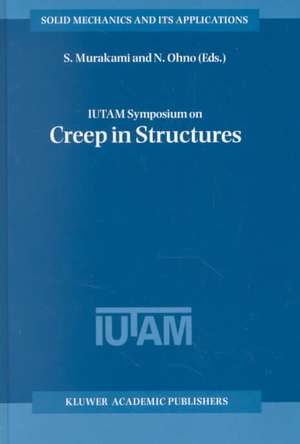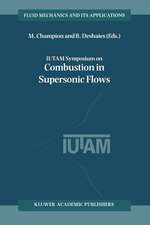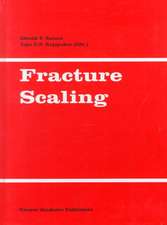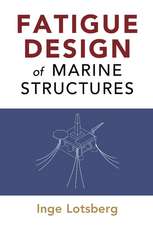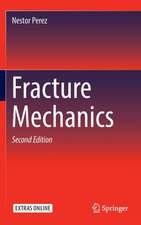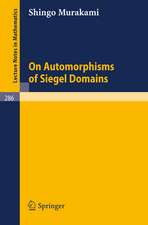IUTAM Symposium on Creep in Structures: Solid Mechanics and Its Applications, cartea 86
Editat de S. Murakami, N. Ohnoen Limba Engleză Hardback – 31 dec 2000
| Toate formatele și edițiile | Preț | Express |
|---|---|---|
| Paperback (1) | 1561.17 lei 38-45 zile | |
| SPRINGER NETHERLANDS – 4 dec 2010 | 1561.17 lei 38-45 zile | |
| Hardback (1) | 1833.95 lei 6-8 săpt. | |
| SPRINGER NETHERLANDS – 31 dec 2000 | 1833.95 lei 6-8 săpt. |
Din seria Solid Mechanics and Its Applications
- 20%
 Preț: 698.09 lei
Preț: 698.09 lei - 24%
 Preț: 800.14 lei
Preț: 800.14 lei -
 Preț: 410.10 lei
Preț: 410.10 lei - 15%
 Preț: 640.06 lei
Preț: 640.06 lei - 15%
 Preț: 653.14 lei
Preț: 653.14 lei - 18%
 Preț: 1124.92 lei
Preț: 1124.92 lei - 15%
 Preț: 643.84 lei
Preț: 643.84 lei - 18%
 Preț: 1119.38 lei
Preț: 1119.38 lei - 20%
 Preț: 573.17 lei
Preț: 573.17 lei - 18%
 Preț: 1607.92 lei
Preț: 1607.92 lei - 17%
 Preț: 393.72 lei
Preț: 393.72 lei - 17%
 Preț: 459.40 lei
Preț: 459.40 lei - 18%
 Preț: 959.98 lei
Preț: 959.98 lei - 18%
 Preț: 747.71 lei
Preț: 747.71 lei -
 Preț: 388.55 lei
Preț: 388.55 lei - 18%
 Preț: 787.15 lei
Preț: 787.15 lei -
 Preț: 406.25 lei
Preț: 406.25 lei - 15%
 Preț: 639.08 lei
Preț: 639.08 lei - 24%
 Preț: 784.82 lei
Preț: 784.82 lei - 15%
 Preț: 643.34 lei
Preț: 643.34 lei - 18%
 Preț: 958.07 lei
Preț: 958.07 lei - 18%
 Preț: 1228.15 lei
Preț: 1228.15 lei - 18%
 Preț: 734.27 lei
Preț: 734.27 lei - 18%
 Preț: 1233.06 lei
Preț: 1233.06 lei - 18%
 Preț: 1236.19 lei
Preț: 1236.19 lei - 18%
 Preț: 950.96 lei
Preț: 950.96 lei - 18%
 Preț: 906.48 lei
Preț: 906.48 lei - 18%
 Preț: 964.54 lei
Preț: 964.54 lei - 20%
 Preț: 995.75 lei
Preț: 995.75 lei - 18%
 Preț: 953.65 lei
Preț: 953.65 lei - 18%
 Preț: 1239.67 lei
Preț: 1239.67 lei - 18%
 Preț: 962.35 lei
Preț: 962.35 lei - 18%
 Preț: 964.54 lei
Preț: 964.54 lei - 18%
 Preț: 913.11 lei
Preț: 913.11 lei - 18%
 Preț: 1226.90 lei
Preț: 1226.90 lei
Preț: 1833.95 lei
Preț vechi: 2236.53 lei
-18% Nou
Puncte Express: 2751
Preț estimativ în valută:
350.92€ • 365.52$ • 292.54£
350.92€ • 365.52$ • 292.54£
Carte tipărită la comandă
Livrare economică 28 martie-11 aprilie
Preluare comenzi: 021 569.72.76
Specificații
ISBN-13: 9780792367376
ISBN-10: 0792367375
Pagini: 522
Ilustrații: XXII, 522 p.
Dimensiuni: 155 x 233 x 30 mm
Greutate: 0.94 kg
Ediția:2001
Editura: SPRINGER NETHERLANDS
Colecția Springer
Seria Solid Mechanics and Its Applications
Locul publicării:Dordrecht, Netherlands
ISBN-10: 0792367375
Pagini: 522
Ilustrații: XXII, 522 p.
Dimensiuni: 155 x 233 x 30 mm
Greutate: 0.94 kg
Ediția:2001
Editura: SPRINGER NETHERLANDS
Colecția Springer
Seria Solid Mechanics and Its Applications
Locul publicării:Dordrecht, Netherlands
Public țintă
ResearchCuprins
An opening address; D.R. Hayhurst. Micromechanism-quantification for creep constitutive equations; B.F. Dyson, M. MCLean. Creep of gamma-TiA1 based alloys: experiments, computational modelling; W.T. Marketz, et al. Anisotropic creep of single crystal superalloys; D.M. Knowles, D.W. MacLachlan. A rate dependent formulation for void growth in single crystal materials; E.P. Busso, et al. Microstructural modeling of creep fracture in polycrystalline materials; P. Onck, et al. Creep crack growth: from discrete to continuum damage modelling; B.-N. Nguyen, et al. Prediction of inner cracking behavior in heat-resistant steel under creep-fatigue condition by means of three-dimensional numerical simulation; N. Tada, R. Ohtani. Creep of welded structures; T.H. Hyde, W. Sun. Two parameter characterization of crack tip fields under creep conditions; A.D. Bettinson, N.P. O'Dowd, et al. Cavity growth induced by electric current and stress in LSI conductor; T. Kitamura, T. Shibutani. Dislocation density simulations for bulk single crystal growth process using dislocation kinetics model; N. Miyazaki. Multiaxial creep fatigue under anisothermal conditions; J.P. Sermage, et al. Constitutive modeling of viscoplastic damage in solder materials; Y. Wei, et al. Consideration of stress state influences in the material modeling of creep, damage; H. Altenbach. Strain, stress, damage fields in damaged, cracked solids; A. Benallal, L. Siad. Effects of damage on the asymptotic fields of a model I creep crack in steady-state growth; S. Murakami, et al. Computational continuum damage mechanics: its use in the prediction of creep in structures: past, present, future; D.R. Hayhurst. Cracking of creeping structures described by means of CDM; A. Bodnar, M.Chrzanowski. A coupled formulation for thermo-viscoplasticity at finite strains: application to hot metal forming; L. Adam, J.P. Ponthot. Thick axisymmetric plate subjected to thermo-mechanical damage; A. Ganczarski. Creep of shotcrete tunnel shells; Ch. Hellmich, et al. Rupture life time prediction, deformation mechanisms during creep of single-crystal nickel-base superalloys; A. Epishin, et al. Creep damage assessment, void formation in engineering materials; H.C. Furtado, I. Le May. Creep damage accumulation, and failure in narrow regions of steel welds; D.J. Smith, et al. Long-term creep life prediction based on understanding of creep deformation behavior of ferritic heat resistant steels; K. Yagi, et al. Near-threshold fatigue 1 crack growth in SUS304 steel at elevated temperatures; S. Kubo, et al. Approximate viscoplastic notch analysis; G.Härkegard, H.-J. Huth. The reference stress method in creep design: a thirty year retrospective; J.T. Boyle, R. Seshadri. Study on creep-fatigue life prediction methods based on long-term creep-fatigue tests for austenitic stainless steel; Y. Takahashi. Developments in creep fracture assessments within the R5 procedures; R.A. Ainsworth, et al. On global approaches to some problems involving plasticity, viscosity effects; K. Dang Van. On the simulation of large viscoplastic structures under anisothermal cyclic loadings; L. Verger, et al. Description of inelastic behavior of perforated plates based on effective stress concept; T. Igari, et al. The overstress model applied to normal, pathological behavior of some engineering alloys; E. Krempl, K. Ho. Creep strain uncertainties associated with testpiece extensometer ridges: their identification, reduction; D.R. Hayhurst, et al. Equivalence of back stress
